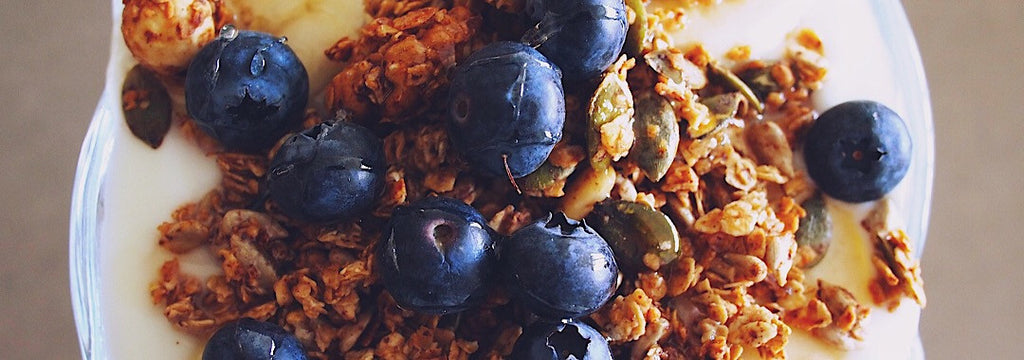
One of the downsides of following a strict gluten-free diet is that you lose a lot of your fiber sources, as many fiber-rich foods are wheat-based.
Fiber is an important part of a healthy diet for numerous reasons:
- It helps maintain an environment of healthy gut bacteria
- It helps with constipation
- It aids in healthy cholesterol and blood pressure levels
- It helps treat belly bloat
- It makes you feel fuller for longer
- It helps you maintain a healthy weight
- It helps avoid complications like heart disease, diabetes, and colon cancer
Long story short: fiber is crucial.
Studies show the average American is only getting around 10-12 grams of fiber a day, which is well below the recommended daily intake of 25 grams for women and 38 grams for men. For those of us following a gluten-free diet, getting enough fiber can be even more difficult with having to avoid grains, cereals and flours.
While a convenient, foolproof way to get your daily fiber intake can be through fiber powders like Metamucil and Citrucel (make sure the powder you choose is gluten-free!), another option is to get all of your daily fiber by adding some of the following choices to your diet regimen. Their multiple health benefits will have you feeling great in no time, with less belly bloat, less hunger pangs, and a better functioning gut!
1. Gluten-Free Cereal
Gluten-free cereals can be hit or miss when it comes to fiber content, so be sure to check out the nutritional value. Some of our favorites, including Nature's Path Mesa Sunrise and Enjoy Life Foods Perky's Crunch Flax, pack in 3 and 6 grams of fiber per serving, respectively.
2. Chickpeas
While beans in general are an excellent source of fiber, they can be intimidating, and people often struggle with ways to add beans to their diet. Enter roasted chickpeas, the best snack in the entire world. A cup of chickpeas provides a whopping 13 grams of fiber. Either make your own at home or try some of the packaged brands of roasted chickpeas with various flavor options here, here and here.
3. Quinoa
Quinoa is a fantastic option for fiber because of all the extra benefits you'll get as well. Quinoa is packed with protein, iron, magnesium, riboflavin, vitamin b6 and manganese. It has twice as much fiber as other grains. Use this superfood as a side dish instead of rice, or add it to salads and soups. We are huge fans of the Pereg quinoas, they come packaged with spices and dried veggies. We love the southern style the most!
4. Nuts
Almonds, peanuts and pecans are your best bets, as a cup of these will give you 15, 12 and 10 grams of fiber, respectively. Buy raw nuts with the skin on to get the best health benefits. Add nuts to salads, granola, yogurt, oatmeal, or create your own high fiber trailmix with nuts, currants, and high fiber cereal.
5. Berries
A cup of raspberries or blackberries contains 8 grams of fiber, folks! Blueberries, currants and strawberries are all excellent options as well. Add berries to your cereal, yogurt or oatmeal, or just grab some as a snack. Dried blueberries are also a yummy choice. I take these to work and love knowing that my afternoon munchies are going towards my daily fiber quota!
6.Oats
One cup of cooked oatmeal provides 4 grams of fiber. Add berries, chia seeds, or ground flaxseeds for an extra fiber boost! Remember to always make sure you're buying oats certified as gluten-free, as other brands may not protect against cross-contamination. A couple of our favorites are Bob's Red Mill Gluten-Free Rolled Oats and Bakery on Main's Maple Multigrain Muffin Instant Oatmeal!
7. Flax
For maximum absorption, flax seeds should be ground or milled, and stored in the refrigerator after they are opened. In addition to being high in fiber, flax seeds are high in omega 3 fatty acids, another key nutrient notoriously lacking in people with celiac disease. Add flax seeds to cereal, salads, or yogurt. And if you bake, you can sneak flax seeds into muffins, cookies, breads and even pancakes.
8. Fruits with Peels and Pits
Grapes, apricots, apples, figs and pears are all excellent sources of fiber. You can also go the dried fruit route and get a fiber boost from raisins, dates and dried apricots. It has been easiest to up my fruit intake by replacing desserts and snacks with fruit as much as possible. Fruit salad with some high fiber fruits, chopped walnuts, and crystalized ginger chips is a super tasty treat.
Some extra tips: To make sure that your added fiber is as effective as possible, drink plenty of water and make moderate exercise a part of your routine (even 20 minutes of cardio once a day is great)! Also, if your fiber intake is very low, start out gradually. Our bodies are sensitive to change and overloading your system with fiber could potentially cause some discomfort. Try adding a few grams at a time until you're up to the recommended daily level.
Here's to all of us reaching our daily fiber goals! What are some of your tricks to sneaking enough fiber into your diet?




Comments
edward :
thanks
Aug 29, 2017
Leave a comment